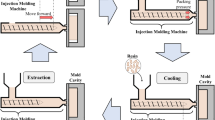Abstract
Plastic composites are used in vehicle components to improve fuel efficiency. Thus, the warpage of injection-molded plastic parts has become a quality issue. Factors, such as product shape and thickness, resin, and other injection molding conditions, can be modified to improve the warpage problem. However, if these factors are set with no possible adjustments, reverse engineering may be required. Reverse engineering is a difficult process that requires many trials and errors; thus, it is only used as a last resort. With respect to the warpage issue, reverse engineering considers the following: (1) Predicting and (2) modeling the warpage in opposite directions. Autodesk Moldflow Insight accommodates these key considerations, but many researchers are reluctant to use it. Although existing injectionmolding analysis programs are mainly used to predict qualitative results, computer-aided engineering (CAE) for reverse engineering requires quantitative analysis. Hence, the considerations are different from the existing analyses. An error in warpage prediction may lead to a costly mold modification because of the molds' complex structures. Quantitative warpage prediction for reverse engineering depends on process variables; thus, understanding how warpages are affected by uncertain process variables is important to improve the reliability of reverse engineering. Moreover, even if appropriate process variables are set, they cannot be applied due to tolerance in lengths. For this reason, mold shrinkage must be identified before designing a mold. This study conducted injection molding analysis for a radiator tank that uses glass fiber-reinforced plastic using Autodesk Moldflow Insight 2018.2. Data for warpage prediction were generated in accordance with five process variables to identify the relationship between the level of warpage and process variables. CAE also showed the level of mold shrinkage that can reduce warpage. In addition, a predictive model was created using the multilayer perceptron (MLP)- supervised learning technique, which is a deep learning method for artificial neural networks. The predictive model was compared with typical regression models, such as polynomial regression (also known as response surface model), EDT and RBF, to determine the optimal approximation model. The real modeling time for a radiator tank product is 1 h, but the MLP approximation model required only 1 min and 8 s to perform 8530 iterations with a similar reliability.
Similar content being viewed by others
References
D. V. Rosato and M. G. Rosato, Injection Molding Handbook, 3rd Ed., Kluwer Academic Publishers, Norwell, USA (2000).
S. G. Advani and C. L. Tucker III, The use of tensors to describe and predict fiber orientation in short fiber composites, J. Rheol., 31 (1987) 751–784.
G. P. Tandon and G. J. Weng, The effect of aspect ratio of inclusions on the elastic properties of unidirectional aligned composites, Polym. Compos., 5 (4) (1984) 327–333.
J. Shoemaker, Moldflow Design Guide, Hanser Publications, Cincinnati, USA (2006).
S. H. Hwang, S. H. Park, K. Y. Park, S. J. Hwang and J. H. Lee, Moldflow Basic Course, Chung-Dam Books, Paju, Korea (2014).
H. Zhou, Computer Modeling for Injection Molding: Simulation, Optimization, and Control, John Wiley & Sons, Hoboken, USA (2012).
PIDOTECH Inc., Progress Integration, Automation and Optimization - PIAnO User’s Manual, PIDOTECH Inc., Seoul, Korea (2018).
Z. Changming, Research on injection mold design based on reverse engineering, 2010 2nd International Conference on Computer Engineering and Technology, China (2010) V6-663-V6-665.
C. H. Park, J. M. Park, J. H. Choi, B. O. Rhee and D. H. Choi, Multi-objective optimization of an injection mold cooling circuit for uniform cooling, Transactions of KSAE, 20 (1) (2012) 124–130.
R. Zheng, R. I. Tanner and X.-J. Fan, Injection Molding, Springer Science & Business Media, Berlin, Germany (2011).
K. J. Bathe, Finite Element Procedures, Prentice Hall Inc., Upper Saddle River, USA (1996).
J. D. Martinez-Morales, E. R. Palacios-Hernandez and G. A. Velazquez-Carrillo, Artificial neural network based on genetic algorithm for emissions prediction of a SI gasoline engine, J. Mech. Sci. Technol., 28 (6) (2014) 2417–2427.
Acknowledgments
This research was supported by the Ministry of Trade, Industry and Energy, Korea (Project No.KM180172, 10067766).
Author information
Authors and Affiliations
Corresponding author
Additional information
Recommended by Guest Editor Maenghyo Cho.
Soonhwan Hwang is currently working at ED&C. He teaches injection molding simulation and provides consultation and technical support. He is a Certified Expert Moldflow® Insight Consultant. He is a second year Ph.D. student in smart convergence consulting in Hansung University, Korea. His research interests include computer-aided engineering, injection molding process, injection mold design, multilayer perceptron, and artificial neural networks.
Rights and permissions
About this article
Cite this article
Hwang, S., Kim, J. Injection mold design of reverse engineering using injection molding analysis and machine learning. J Mech Sci Technol 33, 3803–3812 (2019). https://doi.org/10.1007/s12206-019-0723-1
Received:
Revised:
Accepted:
Published:
Issue Date:
DOI: https://doi.org/10.1007/s12206-019-0723-1




